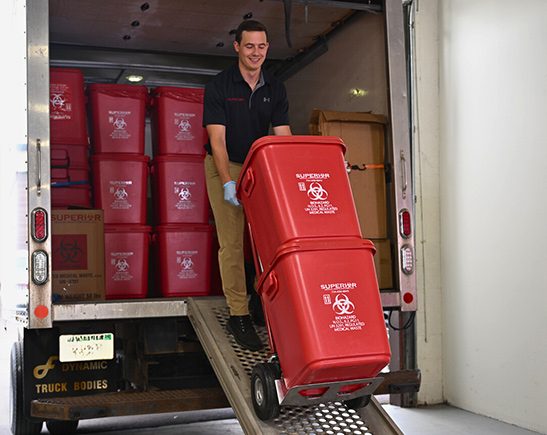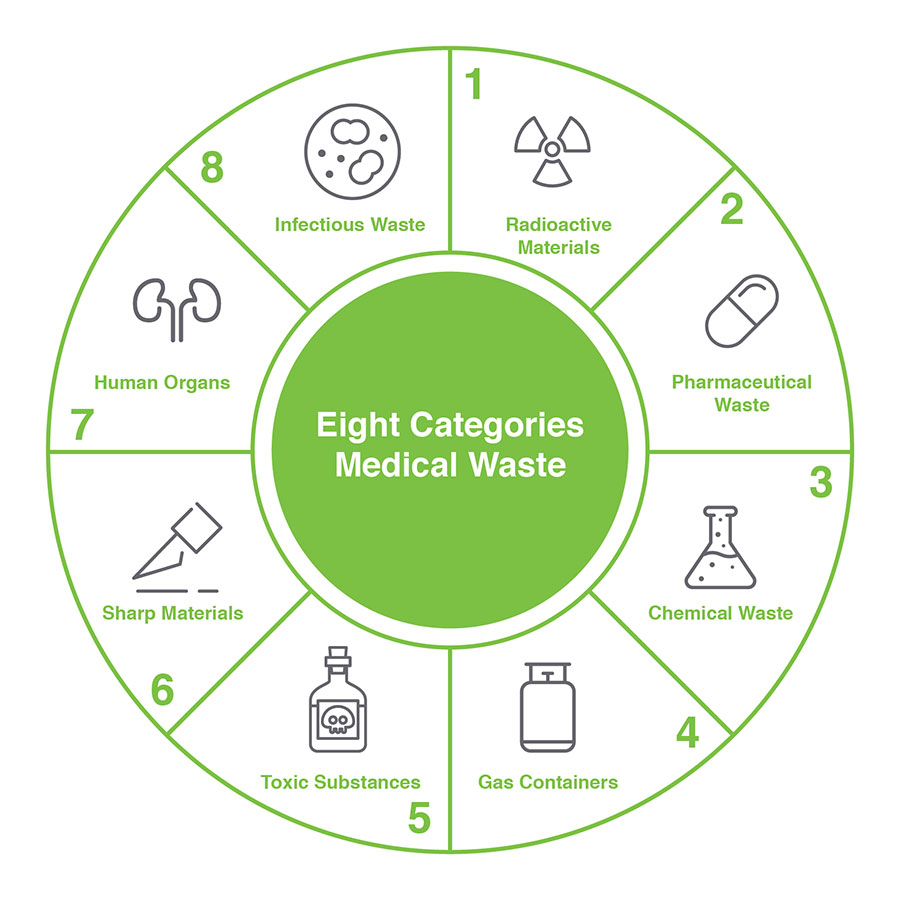Medical Waste Removal Proficiency: Where Service Quality Fulfills Wellness Standards
Medical Waste Removal Proficiency: Where Service Quality Fulfills Wellness Standards
Blog Article
The Value of Proper Medical Garbage Disposal: An Overview for Healthcare Facilities
Correct clinical garbage disposal is an essential facet of health care center management, guaranteeing the safety and health of patients, staff, and the setting. From comprehending the different groups of clinical waste to abiding by regulatory needs, health care facilities need to take on efficient waste segregation techniques and pick suitable disposal methods. Nonetheless, the value of proper clinical waste disposal exceeds simple conformity; it is a responsibility that calls for continuous training and education and learning for personnel. In this guide, we will check out the various facets of clinical waste disposal and highlight the essential steps that medical care centers ought to take. By executing these practices, health care facilities can mitigate threats, safeguard public health, and add to a cleaner, safer environment.
Understanding Clinical Waste Categories
Comprehending clinical waste groups is crucial for proper disposal in healthcare facilities. Medical waste is a broad term that incorporates various kinds of waste created in medical care setups, such as medical facilities, centers, and labs. Classifying medical waste helps ensure that it is taken care of, kept, and disposed of safely and in conformity with relevant guidelines.
There are several groups of clinical waste that medical care facilities require to be mindful of. These classifications include transmittable waste, sharps waste, pharmaceutical waste, chemical waste, and radioactive waste (medical waste disposal services with WasteX). Each group has specific features and calls for different disposal approaches to lessen the threat of harm to health care employees, patients, and the environment
Infectious waste, for example, refers to throw away polluted with potentially contagious materials, such as blood, body fluids, and cells. Drug waste is composed of run out or extra drugs, while chemical waste is composed of unsafe chemicals made use of in clinical procedures.
Compliance With Regulatory Requirements
Healthcare centers need to make certain conformity with regulative demands for correct clinical garbage disposal. Regulative bodies, such as the Epa (EPA) and the Occupational Security and Health Management (OSHA), have developed regulations and standards to guard public health and the setting. These guidelines outline the correct handling, storage space, transportation, and disposal of clinical waste.
Conformity with regulatory demands is essential for healthcare facilities to stay clear of legal penalties, reputational damages, and potential damage to human health and the environment. Failing to follow these laws can lead to penalties, claims, and even the suspension or cancellation of running licenses.
To make sure conformity, medical care facilities need to establish comprehensive waste management programs that consist of personnel training, appropriate waste partition, and the use of ideal containers and labels. Regular audits and examinations ought to likewise be conducted to determine any kind of non-compliance concerns and address them immediately.
It is necessary for medical care facilities to keep up to date with changes in regulations and upgrade their waste monitoring practices accordingly. This can be accomplished by proactively keeping track of updates from regulative bodies and taking part in training programs and workshops.
Executing Reliable Waste Partition Practices
To guarantee appropriate clinical garbage disposal, healthcare facilities should carry out effective waste segregation practices. Waste segregation is an essential action in the general waste monitoring procedure, as it helps minimize the risk of infection, avoids cross-contamination, and makes sure the secure disposal of various sorts of waste. Efficient waste partition methods include dividing clinical waste into various categories based on its characteristics and potential risks.
One typical method is the segregation of sharps waste, such as needles and scalpels, from other sorts of clinical waste. Sharps waste must be put in puncture-resistant containers to protect against injuries and possible infections. Furthermore, hazardous waste, such as chemicals and pharmaceuticals, need to be divided from basic clinical waste to avoid environmental contamination.
Appropriate go to my site labeling and color-coding of waste containers are crucial for reliable waste segregation. Visible and clear labels need to be positioned on each container to show the sort of waste it includes and any special delivery requirements - medical waste disposal services with WasteX. In addition, color-coding can be used to distinguish in between different waste classifications, making it less complicated for health care team to dispose and identify of waste appropriately
Regular training and education and learning for healthcare personnel is vital for the effective execution of waste segregation methods. Staff members ought to be informed on the various waste classifications, correct partition techniques, and the value of adhering to waste management procedures. This will aid make certain compliance and consistency in waste segregation methods throughout the center.
Finding Appropriate Disposal Approaches
Correct choice of appropriate disposal techniques is important in making sure the secure and eco responsible monitoring of medical waste in health care facilities. Health care centers generate a variety of medical waste, including sharps, infectious waste, pharmaceutical waste, and chemical waste - medical waste removal. Each kind of waste needs certain disposal methods to straight from the source minimize the danger of contamination, injury, and environmental damage
One common disposal technique for medical waste is incineration. Incineration includes the regulated burning of waste at heats. This method works in damaging microorganisms and lowering the quantity of waste. It can launch hazardous toxins into the air if not properly regulated.

Chemical disinfection is one more approach utilized for sure kinds of clinical waste, such as pharmaceutical waste. This approach uses chemicals to counteract or have a peek here destroy impurities. Nonetheless, it is essential to select chemicals that are risk-free and environmentally pleasant.
Sometimes, land fill disposal may be appropriate for non-hazardous clinical waste (medical waste disposal services with WasteX). Appropriate partition and packaging are important to avoid leakage or contamination.
Inevitably, medical care centers should meticulously examine the characteristics of their medical waste and select ideal disposal approaches that prioritize safety, ecological defense, and regulatory conformity. Normal training and monitoring are vital to make certain that health care staff adheres to proper disposal procedures.

Training and Educating Staff on Appropriate Disposal Treatments
Team education and training play a vital duty in ensuring the appropriate disposal of clinical waste in health care centers. It is vital that all personnel, including doctors, registered nurses, professionals, and assistance team, get comprehensive training on correct disposal procedures. This training must cover the different kinds of clinical waste, their possible risks, and the appropriate approaches for dealing with, setting apart, and getting rid of them.
Among the main goals of team education and learning and training is to guarantee that all health care professionals comprehend the relevance of appropriate disposal procedures and the potential consequences of inappropriate waste monitoring. They need to be mindful of the threats related to clinical waste, such as the transmission of infections and the contamination of the setting. medical waste removal services. By comprehending these risks, team member will certainly be extra motivated to adhere to appropriate disposal procedures and take the necessary safety measures to shield themselves, their associates, and the area
Educating should likewise cover the use of personal protective tools (PPE) and the proper techniques for managing clinical waste. Personnel should be informed on how to recognize and set apart different kinds of waste, such as sharps, transmittable waste, and unsafe chemicals. They ought to additionally be educated on the proper use of waste containers, such as sharps containers and biohazard bags, along with the significance of labeling and sealing these containers correctly.
In addition, team education and training should consist of regular updates and refresher training courses to guarantee that medical care experts stay notified concerning the most current laws and finest methods in clinical waste disposal. This recurring education is critical to maintain a high level of awareness and compliance amongst team member.
Verdict
In verdict, proper medical waste disposal is of utmost importance for health care centers. Recognizing the various categories of medical waste and conforming with governing requirements ensures the safety and security and well-being of both healthcare employees and the basic public.
From comprehending the different groups of medical waste to conforming with regulatory requirements, health care centers have to take on efficient waste segregation practices and select proper disposal approaches. These categories include transmittable waste, sharps waste, pharmaceutical waste, chemical waste, and contaminated waste.To ensure appropriate medical waste disposal, medical care facilities need to implement effective waste partition practices. Waste segregation is an essential step in the general waste monitoring process, as it helps lessen the danger of infection, protects against cross-contamination, and ensures the risk-free disposal of various kinds of waste. Healthcare facilities produce a range of medical waste, consisting of sharps, infectious waste, pharmaceutical waste, and chemical waste.
Report this page